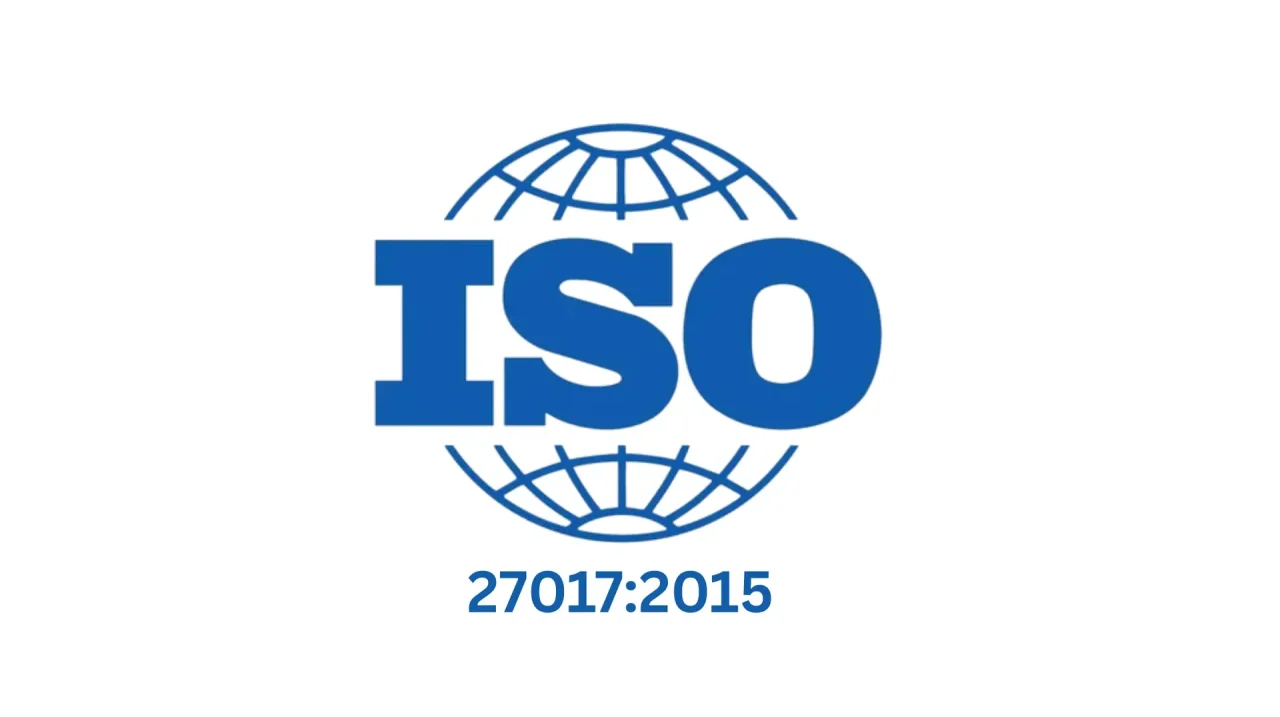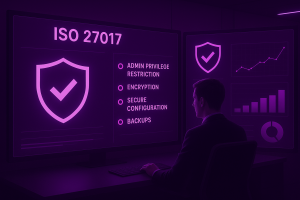ISO/IEC 27017:2015

Cloud computing has become the backbone of modern business operations. From startups to multinational corporations, organizations are increasingly migrating critical workloads to the cloud to achieve scalability, efficiency, and cost savings. However, this rapid adoption comes with significant security and compliance challenges. Businesses must ensure that sensitive data remains protected, privacy laws are respected, and customers can trust their cloud service providers (CSPs). This is where ISO/IEC 27017 becomes a vital framework. Recognized internationally, ISO/IEC 27017 provides a comprehensive set of guidelines for information security controls in cloud services. It bridges the gap between traditional information security management and the unique risks of cloud computing, making it a powerful tool for both cloud providers and their customers.

What is ISO/IEC 27017?
ISO/IEC 27017, officially titled “Code of practice for information security controls based on ISO/IEC 27002 for cloud services”, was jointly published by the International Organization for Standardization (ISO) and the International Electrotechnical Commission (IEC).
It is an extension of the globally recognized ISO/IEC 27001 standard, which defines how to build an effective Information Security Management System (ISMS). While ISO/IEC 27001 covers general security practices applicable to all organizations, ISO/IEC 27017 focuses specifically on cloud computing environments.
Cloud services introduce complexities that traditional IT infrastructures do not, such as multi-tenancy, virtualization, third-party integrations, and data portability. ISO/IEC 27017 provides additional controls and guidelines to address these issues and ensure security responsibilities are clearly defined between providers and customers.
Why is ISO/IEC 27017 Important?
The importance of ISO/IEC 27017 lies in its ability to reduce risk and strengthen trust in cloud adoption. Here are the main reasons why organizations and cloud providers should pay attention to this framework:
- Clarifies the Shared Responsibility Model
Cloud security is not the sole responsibility of the provider. Customers also play a crucial role in configuring, monitoring, and managing their data. ISO/IEC 27017 helps define who is responsible for what, reducing ambiguity. - Builds Customer Trust
A cloud provider certified against ISO/IEC 27017 signals to customers that their security practices align with international best practices. This builds confidence and can be a decisive factor for businesses choosing a provider. - Mitigates Cloud-Specific Risks
Traditional frameworks may overlook cloud-related threats like insecure APIs, misconfigured virtual machines, or weak data segregation in multi-tenant environments. ISO/IEC 27017 addresses these risks directly. - Supports Regulatory Compliance
The framework complements regulations like GDPR, HIPAA, and local data protection laws. Organizations aligning with ISO/IEC 27017 can more easily demonstrate compliance during audits. - Enhances Business Reputation
In a competitive marketplace, being certified to ISO/IEC 27017 helps cloud providers stand out and gives customers peace of mind that their data is handled securely.
Key Security Controls in ISO/IEC 27017
ISO/IEC 27017 builds on the security controls of ISO/IEC 27002 and adds seven cloud-specific controls. These include:
- Shared Roles and Responsibilities
Defines which tasks belong to the provider and which belong to the customer. For example, the provider may secure physical infrastructure, while the customer configures access controls. - Removal and Return of Cloud Assets
Provides guidance for securely deleting or returning customer data and resources at the end of a contract, reducing the risk of data leaks. - Virtualization Security
Ensures strong isolation between virtual machines in a shared environment, minimizing the risk of “cross-tenant” attacks. - Administrative Operations and Customer Monitoring
Ensures customers can monitor the provider’s activities related to their data and verify compliance. - Cloud Service Agreements (CSAs)
Stresses the importance of contracts that clearly state security responsibilities, data handling practices, and incident response commitments. - Data Protection and Segregation
Implements safeguards to prevent unauthorized access or leakage of customer data in multi-tenant architectures. - Incident Management for Cloud Services
Provides guidelines on how providers and customers should handle security incidents collaboratively, ensuring timely detection, reporting, and response.
These controls complement existing ISO/IEC 27001 requirements and directly address scenarios unique to cloud environments.
Benefits of Implementing ISO/IEC 27017
For Cloud Service Providers (CSPs):
- Market Differentiation: Certification acts as a competitive advantage when attracting clients.
- Improved Transparency: By clarifying roles and responsibilities, providers reduce disputes with customers.
- Regulatory Readiness: Easier alignment with data protection laws and industry-specific regulations.
- Stronger Security Posture: Helps mitigate risks like data breaches, insider threats, or poor access controls.
For Cloud Customers:
- Informed Provider Selection: Customers can choose CSPs certified in ISO/IEC 27017 with confidence.
- Reduced Risk of Misconfiguration: Clear guidelines prevent oversight in shared security responsibilities.
- Assurance of Data Security: Ensures sensitive data is protected with proven international practices.
- Lower Compliance Burden: Alignment with regulatory requirements becomes easier when the provider already meets ISO/IEC standards.
ISO/IEC 27017 vs. ISO/IEC 27018
Many organizations confuse ISO/IEC 27017 with ISO/IEC 27018. While they are closely related, they address different aspects of cloud security:
- ISO/IEC 27017: Focuses broadly on security controls in cloud environments, addressing responsibilities, virtualization, monitoring, and contracts.
- ISO/IEC 27018: Focuses on protection of personally identifiable information (PII) in public cloud environments.
In practice, many cloud providers adopt both standards to cover the full spectrum of security and privacy requirements.
Who Should Adopt ISO/IEC 27017?
ISO/IEC 27017 is relevant to a wide range of organizations, including:
- Cloud Service Providers (CSPs): To demonstrate trustworthiness and compliance.
- Enterprises and SMEs: Especially those relying heavily on SaaS, PaaS, or IaaS solutions.
- Highly Regulated Industries: Finance, healthcare, government, and defense organizations benefit most, as they handle sensitive or classified data.
- Third-Party Vendors: Any business offering services that integrate with the cloud can benefit by adopting ISO/IEC 27017.
Even smaller businesses can gain by aligning with the framework, as it strengthens resilience and builds customer confidence.
Steps to Achieve ISO/IEC 27017 Certification
- Understand the Requirements: Review ISO/IEC 27017 and compare it with your current cloud security practices.
- Conduct a Gap Analysis: Identify areas where your controls fall short.
- Implement Cloud-Specific Controls: Address gaps by applying the seven cloud-specific controls.
- Integrate with ISO/IEC 27001: If you already follow ISO/IEC 27001, extend your ISMS to include ISO/IEC 27017.
- Internal Training and Awareness: Educate staff and customers about their roles in shared security.
- Audit and Certification: Work with an accredited body to get certified and demonstrate compliance.
How Sahl Helps with ISO/IEC 27017 Compliance
Achieving and maintaining ISO/IEC 27017 compliance can be challenging without the right tools. Many organizations struggle with manual audits, scattered documentation, and unclear mappings between cloud-specific controls and broader security frameworks. This is where Sahl’s Compliance Automation Software makes a difference.
Sahl provides a centralized compliance management platform that automates the implementation and monitoring of ISO 27017 controls. With features like real-time control tracking, automated evidence collection, and audit readiness dashboards, businesses can ensure that both cloud providers and customers are continuously aligned with ISO 27017 requirements.
In addition, Sahl maps ISO 27017 controls against other frameworks like ISO 27001, NIST, and GDPR, reducing duplication of effort and simplifying multi-framework compliance.
For cloud service providers, Sahl enhances transparency by enabling them to demonstrate compliance to clients and auditors with ease. For cloud customers, it provides visibility into shared responsibility obligations, ensuring no security gaps are left unaddressed. Ultimately, Sahl helps organizations save time, reduce costs, and build lasting trust in their cloud security practices.
Conclusion
Cloud computing is here to stay, but with opportunity comes risk. Data breaches, insider threats, and unclear responsibilities can all undermine trust in cloud services. ISO/IEC 27017 offers a globally recognized framework to mitigate these challenges, enabling providers and customers to collaborate on a secure, compliant, and resilient cloud environment.
Adopting ISO/IEC 27017 not only protects sensitive assets but also delivers a business advantage. Customers are more likely to choose cloud providers that can demonstrate compliance with international standards. Likewise, organizations leveraging cloud services gain clarity, confidence, and regulatory readiness.
For businesses looking to simplify ISO 27017 adoption, compliance automation platforms like Sahl’s Compliance Automation Software can streamline control monitoring, reduce audit fatigue, and keep your organization continuously secure.
FAQs
1. Why should organizations adopt ISO/IEC 27017?
Adopting ISO 27017 helps organizations build trust with clients, demonstrate commitment to cloud security, reduce risks of data breaches, and gain a competitive edge in highly regulated industries.
2. How is ISO 27017 different from ISO 27001?
ISO 27001 provides the general framework for an Information Security Management System (ISMS), while ISO 27017 extends it with cloud-specific security controls such as virtualization, shared responsibility, and customer monitoring.
3. Who needs ISO/IEC 27017 certification?
Both cloud service providers (CSPs) and cloud customers can benefit. Providers use it to prove they follow strong cloud security practices, while customers use it to validate vendor compliance and strengthen contractual trust.
4. What are some key controls in ISO 27017?
Controls include secure virtual machine separation, monitoring of provider activity, secure asset return, data deletion, and clarifying shared responsibilities between provider and client.
5. Is ISO/IEC 27017 mandatory?
No, it is not legally mandatory. However, many businesses adopt it voluntarily to improve security, gain a competitive advantage, and assure clients of robust cloud security practices.
6. How can Sahl help with ISO/IEC 27017 compliance?
Sahl automates compliance management by mapping ISO 27017 controls, collecting evidence, and enabling real-time monitoring. It helps organizations save time, reduce audit costs, and achieve continuous compliance.

